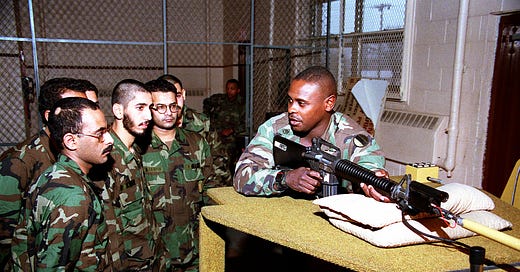Why Army Simulators Fail
How the Army wastes money on small arms simulators and what to do about it.
Over the past half-century, the U.S. Army has implemented a number of small arms simulators. These have ranged from the Weaponeer, MACS (Multipurpose Arcade Combat Simulator), LMTS (Laser Marksmanship Training System), EST (Engagement Skills Trainer), MMTS (Mobile Marksmanship Training System), among others. These have spanned multiple decades. Compared to arcade games, think of them ranging from pinball to home console video games to theater surround sound systems.
Every one of them has been a failure. Here’s why.
All formal data published since the end of World War 2 shows that Soldier skill with small arms has steadily declined. Every change to qualification standards has reduced the challenge and Soldier skill has followed it ever downward.
This is not the fault of the simulators. All of them are effective tools and could have helped, but a tool is only as good as the person wielding it.
There are two significant flaws in every simulator ever put in use:
1. Low availability: Soldiers never see or use them often enough to matter.
2. Poor leadership/organization: Most units fail to consistently make use of whatever they have available and don’t have a reasonable plan to get personnel more skilled.
Most Soldiers that shoot well do so on their own or by accident. While the Army continues to spend millions and millions of tax-payer dollars on simulators and lackluster training with ever-diminishing results, competition shooters continue to win matches with no-cost dry practice.
The issue is having a practice method readily available for regular use and then implementing some sort of sensible plan to regularly use it. That is the real win.
Army qualification has been binary (hit/miss) on full-size, 6 MOA (or bigger) targets since Trainfire began in 1955. All any effective simulator needs to do is differentiate hits and misses. Plain old dry practice works very well, provided the shooter pays close attention and actually cares. Simulators provide an objective measure in dry practice for the majority of Soldiers that will never truly care to be better shooters so that dry practice doesn’t devolve into bad castanet playing (i.e., random, purposeless clicking without paying attention).
A Reserve center with a row of old MACS or Weaponeers lined up like pinball machines that actually get used during every drill/BA is better off than the entire Army with the newest simulator that most personnel rarely see.
I was a fan of the LMTS when it first came out primarily because the original plan of use was to issue them (460 Sustainment Kit) directly to units for them to keep and permanently own. No need to check out and return to a Training Support Center (TASC or ATSC) nor schedule in Range Facility Management Support System (RFMSS). The plan also included a quarterly Validation sequence that re-familiarized everyone in the unit. Those shooting well enough to pass could complete their quarterly Validation in a few minutes; lower-skilled shooters that didn’t pass could practice more as needed during every drill/BA they attended. This allowed an entire unit to practice and test at least four times prior to every live fire qualification, with additional practice for those needing more.
Of course, short-sighted leaders derided this as inferior because it lacked all the features a more expensive option had, ignoring the fact that a 70% solution immediately available is better than a 99% solution that we don’t have access to.
The real failure is that NONE of these simulator systems and programs were promoted and their use enforced. Units used them as they saw fit… or didn’t. LMTS gear got stashed in the back corners of unit equipment cages, only to be seen when accounted for during a mandatory inventory. The other equipment was too expensive to be owned by individual units and saw even less use. Ultimately, taxpayers have had their money wasted on simulators that the Army consistently fails to make use of. Meanwhile, competition shooters dry fire at home for no cost and win matches.









I worked for Beamhit and did a lot of predeployment training on the LMTS and its sniper cousin the STS. And ran a lot of training on the FATS/EST stuff. They had some good points but all in all I dont think they were ever used correctly. The LMTS was a great way to boresight...but other than that..meh...